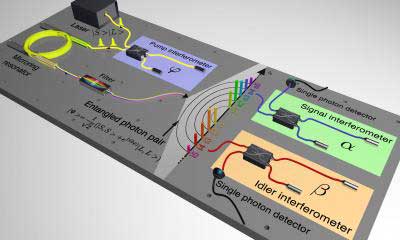| Posted: Apr 27, 2016 |
Researchers create a first frequency comb of time-bin entangled qubits
(Nanowerk News) Quantum mechanics, with its counter-intuitive rules for describing the behavior of tiny particles like photons and atoms, holds great promise for profound advances in the security and speed of how we communicate and compute.
|
|
Now an international team of researchers has built a chip that generates multiple frequencies from a robust quantum system that produces time-bin entangled photons. In contrast to other quantum state realizations, entangled photons don't need bulky equipment to keep them in their quantum state, and they can transmit quantum information across long distances. The new device creates entangled photons that span the traditional telecommunications spectrum, making it appealing for multi-channel quantum communication and more powerful quantum computers.
|
|
"The advantages of our chip are that it's compact and cheap. It's also unique that it operates on multiple channels," said Michael Kues, Institut National de la Recherche Scientifique (INRS), University of Quebec, Canada.
|
 |
| New device creates entangled photons that span the traditional telecommunications spectrum, making it appealing for multi-channel quantum communication and more powerful quantum computers. (Image: Michael Kues, Institut National de la Recherche Scientifique (INRS), University of Quebec, Canada)
|
|
The researchers will present their results at the Conference on Lasers and Electro-Optics (CLEO), which is held June 5 -10 in San Jose, California.
|
|
The basis of quantum communications and computing lies in qubits, the quantum equivalent of classical bits. Instead of representing a one or a zero, qubits can exhibit an unusual property called superposition to represent both numbers simultaneously.
|
|
In order to take full advantage of superposition to perform difficult calculations or send information securely, another weird quantum mechanical property called entanglement enters the picture. Entanglement was famously called "spooky action at a distance" by Albert Einstein. It links particles so that measurements on one instantaneously affect the other.
|
|
Kues and his colleagues used photons to realize their qubits and entangled them by sending two short laser pulses through an interferometer, a device that directs light beams along different paths and then recombines them, to generate double pulses.
|
|
To generate multiple frequencies, Kres and his colleagues sent the pulses through a tiny ring, called a microring resonator. The resonator generates photon pairs on a series of discrete frequencies, using spontaneous form-wave mixing, thus creating a frequency comb.
|
|
The interferometer the team used has one long arm and one short arm, and when a single photon comes out of the system, it is in a superposition of time states, as if it traveled through both the long arm and the short arm simultaneously.
|
|
Time-bin entanglement is a particularly robust form of photon entanglement. Photons can also have their polarization entangled, but waveguides and other types of optical equipment may alter polarization states.
|
|
Other research groups have generated time-bin entangled photons, but Kues and his colleagues are the first to create photons with multiple frequencies using the same chip. This feature can enable multiplexed and multi-channel quantum communications and increased quantum computation information capacity.
|
|
Kues notes that the chip could improve quantum key distribution, a process that lets two parties share a secret key to encrypt messages with theoretically unbreakable security. It could also serve as a component of a future quantum computer.
|
|
"In the future you may have a computer with both quantum and classical capabilities. The quantum part would only be used to solve specific problems that are difficult for classical computers," said Roberto Morandotti, a physicist at INRS and leader of the group that developed the chip.
|
|
Before quantum computers reach a desktop near you, they need to be scaled down, in terms of size, and scaled up, in terms of computing power. Morandotti, Kues and colleagues think their chip is a step in the right direction.
|
|
The team is currently working to integrate the lasers, interferometer, and microring resonator of the device into a standard photonic chip, to build logic gates for quantum state manipulation, and to increase the degree of entanglement, which is a measure of the strength of the link between particles.
|

